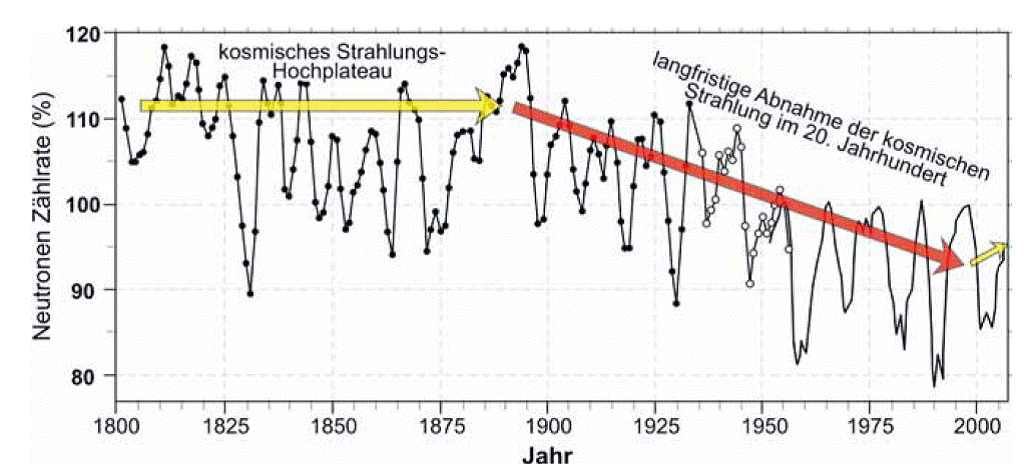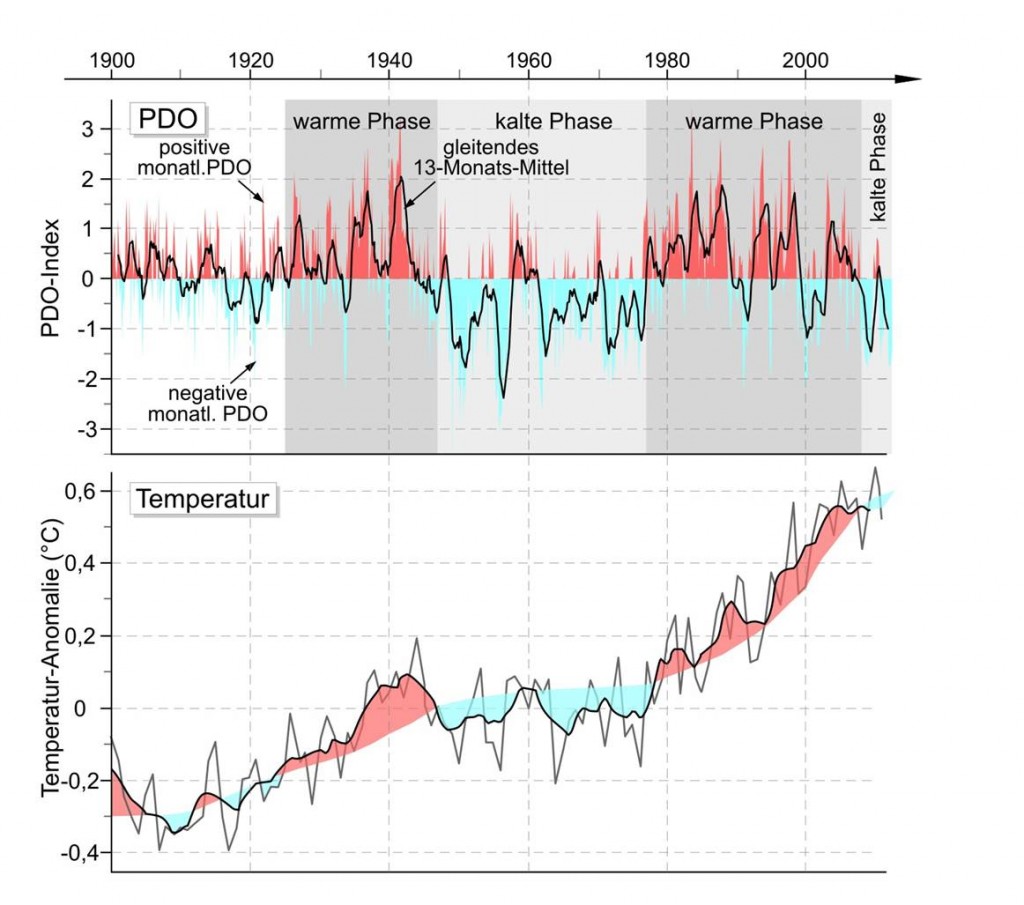If you can't explain the 'pause', you can't explain the cause...Cosmic Rays are Cooler
20th century data supports Svensmark's cosmic ray theory of climate
A post today from the website for the book The Neglected Sun: How the Sun Precludes Climate Catastrophe by German scientists Fritz Vahrenholt and Sebastian Luning shows long term data of cosmic ray proxies for the past 200 years strongly support the Svensmark cosmic ray theory of climate.
Google Translation:


As shown by Figure 2 below, there was essentially no trend in cosmic rays during the 19th century, but a significant decrease during the 20th century, and a slight uptick at the end of the 20th century. Per Svensmark's theory, solar activity controls cosmic rays which in turn affect cloud formation, with cosmic rays inversely related to global temperature. Thus, figure 2 is highly supportive of the Svensmark theory and cause of 20th century warming.
Climate alarmists such as Stefan Rahmstorf of Michael Mann's site RealClimate claim Svensmark's theory is debunked by only cherry-picking the tiny uptick at the end of the 20th century in cosmic ray counts, absurd in comparison to the long-term view.
The post also reviews recent additional papers demonstrating the Sun controls climate, not man-made CO2.
Google Translation:
Michael Odenwald made on 22 November 2013 in the focus thoughts on the climate effects of the sun:
The man or the sun: Who is responsible for climate change?
politicians seem to find any compromises in order to further reduce greenhouse gas emissions. Climate skeptics doubt that measures are necessary at all. In your opinion, should not the man cause global warming, but the sun. Recent studies contradict this.
This is strange. Because most recent studies strengthen the role of the sun rather than to weaken it. Here are some examples:
- New study at the University of Kiel for Neolithic in Ireland: climate cycles caused by fluctuations in solar activity (11/27/2013)
- Led the cold sun of the Little Ice Age in India to increased droughts? (10/06/2013)
- Climatologist Hans von Storch: Climate models may account for changes in solar activity too little (9/13/2013)
- Research team found evidence of a significant influence of the sun on the temperature evolution of the Tibetan plateau (12/09/2013)
- New study in Palaeo3: Solar cycle influence on the climate system of British Columbia (04/09/2013)
- New study in Quaternary Research: variations in solar activity controlled climatic cycles in central China (31.8.2013)
What are supposed to be for "current studies" the words to which Odenwald refers here? This initially remains in the dark, because the opening act of the focus man has Germany's top climate alaramist Stefan Rahmstorf perform with his questionable age-old trick:
Stefan Rahmstorf of the Potsdam Institute for Climate Impact Research (PIL) rejects the idea completely. "The cosmic radiation is measured since 1953. It shows similar to the sun brightness no trend to increase or decrease. Without such a trend can be explained also no change in the cloud cover. "
No trend? The professor liked to joke well. Using geological isotopic methods can be the development of cosmic rays several centuries and even millennia reconstruct back periods, the climate very much more meaningful than the 60 years used by Rahmstorf. And the data speak a very clear language: There is a significant decrease in the cosmic rays in the 20th century, which occurs in parallel with the increase in global temperature ( Figure 2 ). Why deny the obvious trend Rahmstorf and consciously chooses a misleading reference period? What is really behind this wanton feint of research-based environmental activist?

Figure 2: Cosmic rays over the long term during the last 200 years. At the same time the global temperature increased. Figure from "The cold sun", Chapter 6, based on McCracken, KG (2007): Helio Magnetic field near Earth, 1428-2005. Journal of Geophysical Research 112, 1-9.
And one more magician may occur in the opening act, Sami Solanki:
The experts at the Max Planck Institute for Solar System Research (MPS) in Katlenburg-Lindau see no connection. Although would have longer-term variations in solar activity to hot and cold phases, such as the medieval climate optimum, the subsequent Little Ice Age, as well as for heating in the first half of the 20th Contributed century. "But in the 30s, the curves of the solar brightness temperature of the earth and ran for the first time apart," said MPS Director Sami Solanki. "As well the man had a hand in it." Definitively the curves according to Solanki decoupled nearly 30 years ago. The earth's temperature rose sharply, but the sun brightness shows no trend.
Deviations in the 1930s and 1980s? This must surely have made the man! Who else? But wait. Was not there still something? Just the ocean cycles! In the 1930s and 1980s, the Pacific Decadal Oscillation (PDO) increased to their respective maximum value, which drove strong global temperatures upward. Solanki fall into the trap and forgets to take into account this important natural climate cycle. Setback performance. Put six.

Figure 3: synchronicity between temperature cycles and the PDO ocean cycle (PDU = Pacific Decadal Oscillation). From: The cold sun.
Below Odenwald brings new insights into the climate effect of cosmic rays. Some studies negate this context, others hold him still possible. This Odenwald makes the mistake to let an important recent work unmentioned, which we at this point have already reported (see our blog post "Unexpected twist: study in Environmental Research Letters finds regional coupling of cloud cover with solar activity "), namely, a study by Mirela Voiculescu and Ilya Usoskin, in October 2012 in the Environmental Research Letters has been published. We wrote:
Voiculescu works at the Institute of Chemistry, Physics and the Environment 'Dunărea de Jos "University of Galati in Romania, during Usoskin is head of the Arctic research station to cosmic radiation in Oulu, Finland. The two researchers went a bit more differentiated on the matter as many colleagues and distinguished different regions and different clouds Floor. The corresponding combinations then they checked to see if a correlation is noted with solar activity for the period 1984-2009. The investigation period covered thereby two full solar 11-year cycles. As a proxy for the solar activity, the researchers used the cosmic rays and UV radiation. To their surprise, found Voiculescu and Usoskin for certain key regions of a continuous correlation of cloud cover with solar activity over the entire study period. In some areas there is a direct correlation was observed, in others, an opposing. The authors point out that there is no uniform global trend, but it is primarily geographically limited systematic influences. It therefore makes no sense to limit themselves in the search for a solar fingerprint on the global level. Also differed trends and the sun-clouds-coupling for the various clouds Stock Works. In a corresponding expected spatial heterogeneity of the process we had already pointed out in our book "The cold sun" in Chapter 6.
Regardless how or if the cosmic radiation is effective as climatic Solar amplifier, Odenwald would definitely have to point to a second mechanism, namely the UV in the stratosphere. A terrible omission. See for example our blog article " New study describes the missing link in the climate Chain: Polar Stratospheric eddy-rich solar climate signal in the lower atmosphere continue "," International research team: UV solar variation in the climate models so far 4 - underestimated to 6-fold "and" Solar amplifier in the stratosphere: West winds move in cycles of solar activity . "Odenwald do not like the sun, that's for sure. For some reason he picked from the vast literature only works out to support his own subjective perspective. However, this can not be the basis for solid, balanced journalism. He should therefore make thought dear hinüberzuwechseln for Greenpeace Magazine, where you will probably see such personal inclinations rather. The focus slogan "facts, facts, facts" Odenwald is in any case not cope with this biased attitude. Perhaps the Lord Chief Editor should look into this matter again?
Related: prior posts on Svensmark's theory
Comments
Post a Comment